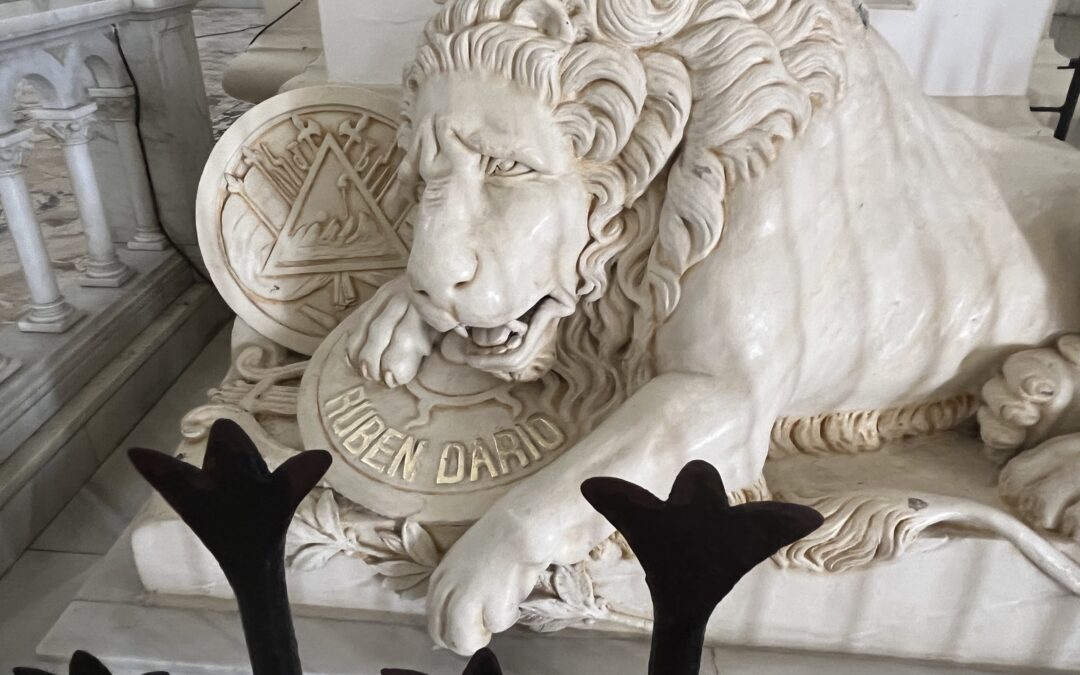León’s abundant colonial heritage
León’s tumbledown bus terminal belies its rich colonial heritage, instantly perceptible in its architecture and structure. The chicken bus chucks its passengers onto León terminal’s sweltering bricks. Tourists are culled. Quick as a wink, my backpack lands in the possession of a rickshaw bicycle taxi. We tussle over fare. As with all Spanish-colonial towns, León has a grid system emanating from the Parque Central. Everything within the city is within walking distance. I put up enough resistance for the driver to know I’ll hoof it if I have to.
Dang, it’s hot. I hope I don’t have to depart the rickshaw and haul my backpack to Coco Calala. I enter its address into my phone. We are close. I side-eye the driver for overcharging me as I hand him his fare. I step off the scorched street into a colonial mansion’s hushed, vaulted foyer. I’m escorted along gleaming black and white tile to my room facing a lush tropical garden.
I relinquish my backpack and head into the breezy evening air of the central garden. Founded in 1524, León is one of the oldest cities in the Americas. This long-standing university town is a center for art, revolution and poetry. I’m at its intellectual center in colonial splendor, dining in its only vegan restaurant among locals that unmistakably love it. The food and service are so fine I would happily take every meal here if I thought I’d be able to resist exploring León’s food scene.
Taken as I am with volcanos, by the time I get to León I’m overcome by heat. I set out Coco Calala’s front door in the tropical morning air, and turn the corner to Pan y Paz, a French owned bakery whose name roughly translates to “Bread and Peace”. Full bodied local coffee and cases groaning with warm, bronzed croissants draw me to its light filtered courtyard. I stride two blocks along crumbling facades and searing brick streets to Parque Central and come up on the largest cathedral in Central America, bright white as fresh-fallen snow against blazing sapphire sky. Its construction lasted half a century. I eye its strict and elegant architecture and time travel.
I return to Cathedral-Basilica of the Assumption of the Blessed Virgin Mary (León Cathedral) each day I’m in León. Then I reconnoiter from the city center’s colonial grid until the heat hounds me back to Coco Cala’s courtyard; its pool my haven. I venture along León’s diverse restaurant landscape and fall back on Coco Cala’s splendid food when the heat depletes me.
José Coronel Urtecho, the great poet from Granada, quipped “Every Nicaraguan is a poet until proven otherwise”. Reading Nicaraguan poetry is experiencing the soul of Nicaragua. Poetry arguably is all that unites Nicaragua after 40 years of revolution, counterrevolution and corruption.
The ethos of the nation’s greatest poet, Ruben Darió, looms largest in León. León Cathedral, a world heritage site, is filled with natural light and forbearing, cool air. I fix my eyes on Darió’s tomb, adjacent to León Cathedral’s alter, guarded by a life-sized white marble sculpture of a mournful lion. I trail Darió’s spirit along his eponymous street to the colonial house he returned to in the final days of his itinerant and nocturnal life.
Terra cotta roofed corridors open up to a courtyard of groomed hedges and tropical blooms that tranquilly confined the poet at his life’s end. Affluent Nicaraguan living is stuck in time here. Artifacts ranging from hand-written exhibits of his celebrated works, to the finery he dressed in as the ambassador to Spain are unobtrusively displayed.
Darió died from complications associated with atrophic cirrhosis of the liver after a long battle with alcoholism. A modest, wrought iron bed and Bible from his agonizing final days poignantly channel his spirit that lives on.

